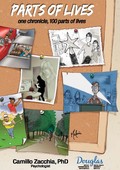Here is something I wrote last December but submitted a little late for publication before Christmas. I made some minor changes and tried again this year. I was lucky enough to have it published in the Montreal Gazette and in the Financial Post (my first time in a national publication!) on December 18, 2008. It is on the psychology of nostalgia.
It’s a Wonderful Film
It happens every time I watch Frank Capra’s It’s a Wonderful Life. Despite my innate cynicism and the fact I know every predictable scene by heart, I still cry when George’s friends and family toast him and sing Auld Lang Syne. And since I’m not the bawling kind of guy, (Chaplin’s City Lights notwithstanding), I think it’s safe to assume most of you cry as well.
So why does this happen? What is it about this movie that makes us react so strongly? One part of the answer, I believe, is simple; it is a movie that takes us out of “look-around mode” and puts us in a “look-behind mode,” a fact that completely changes our perspective.
Change in perspective
It is difficult to appreciate change while we are living it. In fact, it is difficult to appreciate most things while we are living them (with the possible exception of holding a newborn, winning a lottery or your first kiss!). Other than the occasional big event, life usually comes at us in measured doses. We go about our business learning, growing, and connecting to others. None of these things strike us very hard until we look back and contrast where we are now, with where we were then.
This happens with the little things – like hair growing, graying, or thinning – and with the big things – like careers advancing, families growing, and pension funds increasing in value (OK, OK, bad example!). Some changes are simply too gradual to notice on a day-to-day basis. It is only the perspective of time that allows us to see the enormity of them.
When George Bailey was shown what the world would have been like had he not been born, he was given an quick portrait of all that he had experienced in that slow churn of time that comprised his daily existence. The barely perceptible snowflakes of individual experiences became a veritable avalanche when he saw his life as a whole.
Nostalgic memory
Another reason we are moved by films such as It’s a Wonderful Life involves the very nature of nostalgia. Anger and frustration can sometimes mask any positive aspects of an experience when we are living it. But negative feelings fade over time. Positive ones don’t. This leaves behind only the sweet memories. Meanwhile, our present lives confront us with all the usual frustrations making it difficult to fully appreciate the positive. By contrast, the past will always look great.
Just think back to pleasant times in your life. It is easy to conjure up many “better times” or “good old days.” Now ask yourself how you felt at those times. Did you feel good while they were happening?
Let’s take high school as an example. Do high school students ever think, “This is such a great phase in my life, I am surrounded by others my age, I have my whole life ahead of me, I have so much free time and so few responsibilities?” Fat chance. They are far more likely to think, “My face is hideous, I will never have a girlfriend, everyone else is smarter than me, and I’m a freakin’ loser!” Yet somehow, the passage of time makes us forget the acne and the anxiety and allows us to see the beauty of the time. If you want to see happy people, just go to your high school reunion.
Weddings are another great example of the phenomenon. On the day itself, it is not unusual to hear of family members screaming, of brides crying in frustration, and of relatives vowing never to speak to each other again. Yet we often find ourselves, maybe twenty-five years later, looking at a picture and crying because that day was “so perfect!”
Time erases the ugly but insignificant details, and keeps the essence and the beauty of events and experiences.
The importance of symbols
The film also highlights another important element of life; the value of symbols. Symbols can seem fairly insignificant at first. When Zuzu’s petals were put in George Bailey’s pants, they had very little importance. It is when they became a representation of his daughter that they took on great meaning. We all have symbols in our lives – a grainy photograph, a baby tooth, an old watch, even a broken banister – that serve as representations of everything we have and of all we have lived.
The accumulation of wealth
In the end, this movie gets to us by highlighting a very simple and basic message; true wealth is not measured by the accumulation of material goods. The measure of a life’s value is in the accumulation of personal experiences that produce our personalities. It is in the accumulation of knowledge that leads us to the clarity of understanding. And it is in the accumulation of personal contacts that lead to relationships, love, and laughter.
Taken together, they produce a wonderful life!
Tagged as Capra, City Lights, Nostalgia.
Posted in Random thoughts.
Posted on 24 Dec 2008
